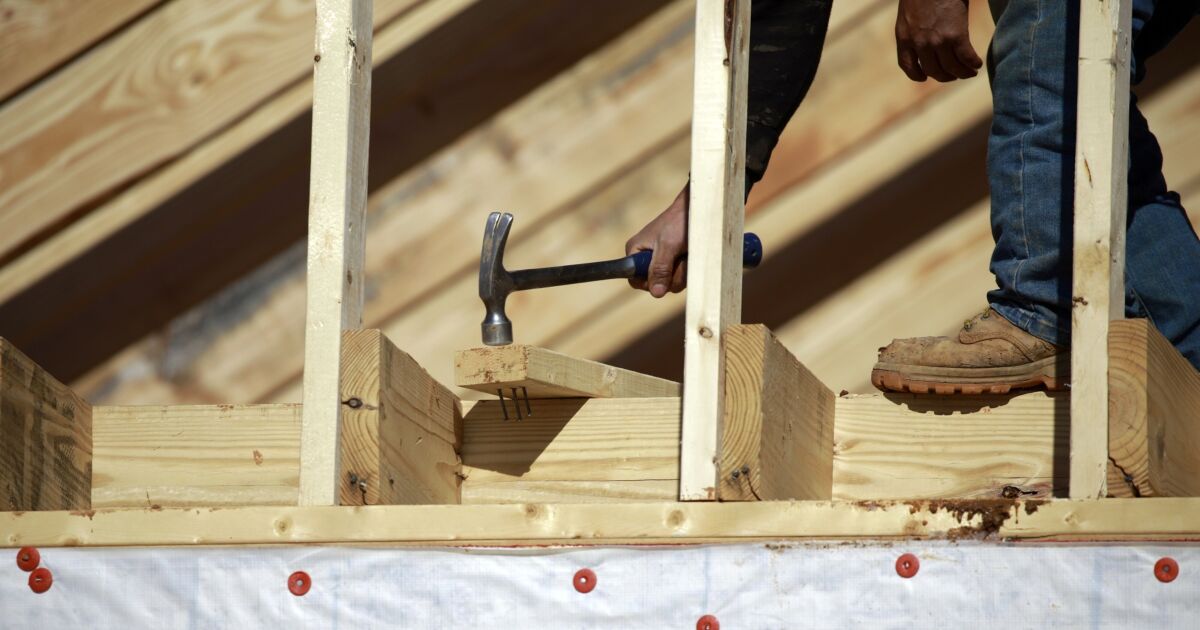
Lenders have renewed interest in establishing ties with builders this spring given the
What the spring will bring remains to be seen, but so far
This spring will follow
RELATED:
"You've got this massive pent-up demand, the biggest population bubble in American history, and not a lot of inventory," said Rick Arvielo, co-founder of New American Funding. He expects this will lead to a competitive new-home market this spring.
Loan activity in this part of the market has been growing, with the non-adjusted Mortgage Bankers Association's builder application index in January hitting the highest level ever in the history of the series.
January's index number of 270 also was the highest adjusted reading on the index since July 2020's 290, said Joel Kan, vice president and deputy chief economist at the Mortgage Bankers Association. The index's baseline started at 100 in August 2012, when the market was slow.
If the MBA's forecast for new home sales is any indication, application numbers will get even higher this spring, Kan said, noting that the association at the time of this writing was projecting a 12.6% increase in new home sales this year vs. 5% for existing properties.
"It might shake out a little differently on the application or origination side, but directionally I think we're going to see something similar," Kan said.
The application index draws sample information solely from builders who don't partner with lenders but instead have captive mortgage units. However, it's considered likely to reflect broader new-home mortgage trends.
It is worth remembering that there are limits to tapping builders as referral sources because large players tend to have captive units and
However, a small number of other relatively large builders and a lot of modest-sized home construction companies are open to working with lenders.
"There are a lot of builders, but many are not very big," Arvielo said.
ALSO READ:
New American serves as a backup lender to some home-construction companies and Arvielo says many of those business relationships started with proactive outreach by mortgage professionals on the company's lending team.
"It is really the loan officers' responsibility. Our loan officers have done a great job and earned the right to do more," he said. "If you want, you can make it more of a corporate initiative to assist them, and get a little bit bigger piece of that pie."
One of the things the company does to help loan officers work with consumers who want to access new construction in a competitive market is to provide
Increased competitionMortgage originators looking to forge builder ties this spring are going to run up against a relatively crowded playing field, said Dan Peña, executive vice president of national joint ventures at Loandepot.
"We never really had much competition in going after the builder partnerships from the top. That's changed dramatically," he said. "Now you've got small regional lenders looking to get into the builder business."
Before attempting to establish these relationships, a mortgage company's leadership should consider whether they're ready to commit long-term to a business that fluctuates in its attractions depending on the market cycle, particularly if they are a smaller firm with limited resources, Peña said.
"Builders get attractive for the industry when refinances aren't there or there's no inventory, but then rates drop, there's a refi boom and the other lenders disappear," Peña said.
Builder sales are likely to continue to be important this year, even if
"I think new-home sales are going to continue to be an important part of the for-sale home market overall, because, while interest rates went down a little bit, there are still a lot of people locked into low mortgage rates," said Kelly Mangold, principal, RCLCO Real Estate Consulting.
Options for partnershipsThere are benefits for a large company committed to formal builder partnerships through multiple business cycles the way Loandepot has been, Peña said.
"Loandepot manages the mortgage company for the builder. The entity has loan officers, production people and leadership, and then there's a servicing agreement with Loandepot. We provide all the mortgage services: processing, underwriting, closing, funding and warehouse management. We do everything, and we charge the joint venture a fee," he said.
Various structures can be used to partner with builders, the most typical being a 50/50 joint venture.
"If a builder is giving me a bigger split, they're probably getting the money somewhere else anyway, whether it's in price, margin or whatever. So we just tend to be very transparent with it, and say, 'Hey, it's 50/50," Peña said.
In some cases, that split may include an option to change over time.
"We've done deals in the past where we know their five- or 10-year plan is to be very large and so we'll say, 'Hey, let's get this thing up and running 50/50 and on year five, you have an option to buy another 5% at X price,'" he said. "We pre-set everything to make sure it's compliant."
Other options for partnerships include marketing service agreements, in which one entity agrees to promote services for the other.
Lenders who use MSAs generally say they ask their compliance experts to verify that they are
There also is another option.
"I would say for the majority of our relationships we're a preferred lender," said Bill Hitchcock, a senior vice president of business development at Atlantic Bay Mortgage Group. These generally resulted from company outreach. The company has JVs and other partnerships too.
A mortgage company is most likely to be an exclusive preferred lender in cases where the builder is smaller.
A larger builder might be more likely to work with a group of preferred lenders, generally those they consider to offer the most favorable service to homebuyers, said Emily Farley Gardner, chief lending officer at Atlantic Bay Mortgage Group.
In some of the less competitive markets, builders and lenders have been offering buydowns and other incentives for new homes and associated loans. But Gardner said these generally don't hurt the new-home business' margins from a lending perspective.
"We don't see any sort of difference between the builder business we do and our other products," she said.
Lenders looking to be preferred lenders have to be comfortable with what could be a long on-ramp to an origination as a property gets built and a full underwriting process rather than just a quick prequalification, followed by a need to conduct a fast closing, Gardner said.
"Things change pretty rapidly, so communication with the borrower about how things are going on the finance and marketing side is just as important as working with the builders," she said.



